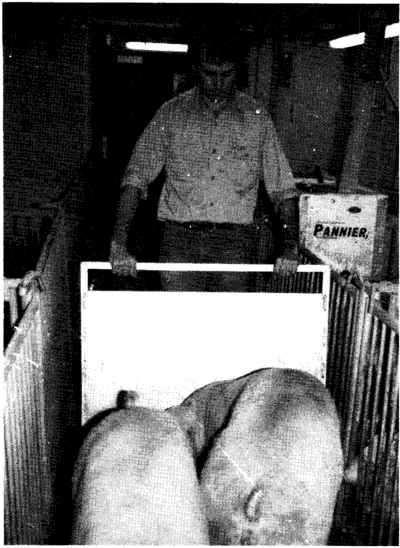
Figure 1. A crowd panel facilitates moving pigs up and down a corridor or an enclosed ramp.
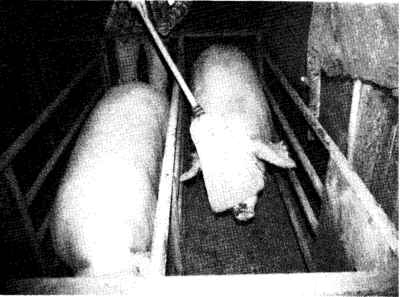
Figure 2. A stubborn pig can be backed up by gently tickling its snout with a broom.
Lab Animal, Vol 15 No 3 April 1986
SWINE ARE RECOGNIZED as valuable models for the study of certain human diseases such as diabetes, atherosclerosis, hypertension, and other cardiovascular disorders, hepatic disorders, skin disorders, and many others (1). While not as easy to handle as dogs and cats, their utility in many types of biomedical studies makes them more appealing as research models to some investigators.
Improper handling of pigs, however, causes considerable stress in the animals and can have a detrimental effect on many of their physiological functions. For example, stress can reduce weight gains (2, 3), lower immune responses (4), alter physiological factors such as blood chemistry (5), and interfere with reproductive processes (6, 7). In one study young pigs were restrained alone in narrow boxes for two hours a day for three days. These animals subsequently showed reduced thymus weights, elevated serum cortisol levels, and reduced cell-mediated immunity (4). In another experiment pigs subjected to an electric shock every time they approached a person in their pen subsequently showed an enlarged adrenal cortex (3). In a similar study pigs were shocked, placed in snout snares, and slapped when they approached a handier. In another group the pigs were petted when they approached a handler. The latter group gained more weight than the former group, and the former group showed increased blood levels of corticosteroids (2).
Pigs can easily be handled in the research environment, with a minimum of stress, if their behavior is understood. Pigs have wide-angle vision, which enables them to see behind themselves without turning their heads (8). Therefore during handling much of their behavior may be visually mediated. Under artificial illumination pigs tend to move from dimly lit areas to more brightly lit areas, especially if the illumination changes uniformly, so that shadows and bright spots are minimized. Pigs often refuse to enter a dark place or cross a shadow, a drain grate, a door threshold, or even an area where the floor color or texture changes. A spotlight directed at the floor of a scale, stall, restraining enclosure, or other dark place helps induce the pigs into entering; however, the light must not be shined into their eyes. They may also refuse to walk on metal drain covers that move and cause noise when stepped on. In planning a new swine facility, therefore, drains should not be located in corridors where pigs will have to walk over them.

Figure 1. A crowd panel facilitates moving pigs up and down a corridor or an enclosed ramp.

Figure 2. A stubborn pig can be backed up by gently tickling its snout with a broom.
It is important to have the correct type of flooring in areas through which pigs are to be moved or temporarily housed if stress is to be reduced during handling. Nonslip floors are especially important in transport cages, corridors, chutes, and crowd pens. In existing facilities a nonslip floor finish can be made by adding grit to a fresh epoxy coating. In new facilities concrete floors in areas where pigs are frequently handled can be made nonslip by imbedding 3/4-in. expanded metal mesh in the surface of freshly poured and troweled concrete and then removing it before the concrete sets. A good flooring material for temporary housing and handling areas is a commercially made plastic-coated expanded metal mesh. This material can easily be cut to size for use in chutes, pens, or transport cages and can even be used in corridors. For large pigs this material should not be used for more than six consecutive weeks; keeping them on this material longer allows excessive hoof growth. A better permanent flooring material for large pigs is concrete covered with a bed of straw or wood chips. Pigs of any size should not be kept on bare concrete floors for very long, as this will cause foot and joint problems such as arthritis.
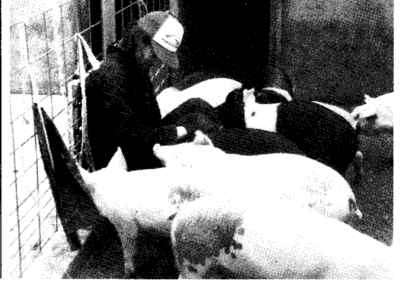
Figure 3. Pigs approach a sitting or kneeling person more readily than one who is standing up.
Some pigs can be stubborn and refuse to back up. In this case, a broom gently brushed across the pig's snout, being careful not to poke it in the eyes, usually causes it to back up. Pigs seem to respond more readily to a broom used in this manner than to a person's hand pushing against the snout. Sometimes even the broom technique does not work. In such a case, a last resort, short of physically forcing the pig to back up, which obviously can be quite stressful to the pig, is to place a shield, such as a plastic bucket, over the pig's eyes. With its eyes shielded, even the most stubborn pig can usually be backed up without resorting to sheer force.
Electric prods should never be used in a research facility as a means of moving pigs. Every time a pig is shocked its heartrate increases, and several shocks in quick succession will cause the heart to beat very rapidly (10). A pig may react to an elevated heartrate by slowing down its movement or simply lying down (13). Continued shocks may cause the pig to die from stress.
In most circumstances, the only driving tool needed, in addition to a crowd panel, is a cane or a piece of thin plastic pipe. The latter is used for turning and guiding pigs. For example, to turn a pig to the right, gently tap it (do not smack it) on the left shoulder or the left side of the neck and vice versa.
Australian scientist Paul Hennsworth measured the time it took pigs to approach and touch him. He found that pigs approached sooner when he squatted in the pen (14). If he stood to approach the pigs, they reacted to him as they would to a threat and backed away. The pigs also approached more readily when his hands were bare.
Animal trainers have learned from experience that when an animal is touched it should be touched firmly; this seems to have a calming effect on the animal. A light touch that just tickles the animal tends to have an alerting effect and triggers a defensive reaction. Once pigs allow you to touch them, stroking the belly usually relaxes them. Stroking the belly of a small pig restrained in a V-trough for blood sampling or other research procedures also relaxes the animal.
Phillip Dziuk of the University of Illinois found from experience that the dominant pig should be handled first. With the odor of the dominant pig on the handler, the other pigs will be more submissive. Recent research suggests that pigs communicate by means of pheromones. For example, injecting a pig with ACTH causes other pigs to dominate and attack it (18), and spraying androsterone (male hormone) in the air reduces fighting between pigs (19).
It was also observed that these pigs seemed to have toy preferences. Cloth strips and pieces of rubber hose were more frequently played with than chains. In addition, a daily cycle of play activity was observed (20, 21).
The pigs avoided toys that were contaminated with manure. To solve this problem toys were suspended over the pens with rope or twine. This kept the toys clean and still allowed the animals to manipulate them almost as freely as though they were on the floors of the pens. In order to maintain the pigs' interest it was necessary to frequently replace the cloth strips. The rubber hose toys did not need to be changed until they became frayed. The best hose for this purpose is the type that has an inner reinforcing fabric.
Experiments in a French laboratory suggested that providing pigs with play objects reduced stress. Deprived or frustrated pigs were provided with leather strips or chains to pull. After playing with these toys the animals showed reduced blood levels of corticosteroids (22). It has also been shown that a trough of dirt added to an otherwise barren pen evokes higher levels of activity. The pigs in this experiment spent less time lying about (23).
Pigs are sensitive to slight changes in their routine. For example, pigs accustomed to a specific routine for blood pressure measurements may respond to a change in their routine with a rise in blood pressure (25). Pigs can be trained, however, to accept irregularities in their feeding and management routines. This training helps reduce stress when experimental protocols call for interruptions in these routines. For example, Reid and Mills showed that it is desirable to train animals not to expect feed at the same time each day if, for experimental reasons, feeding times are to be manipulated (26).

Figure 4. Pieces of reinforced rubber hose and chains suspended over the pen make excellent toys for pigs.
It has been shown that the way an individual herdsman interacts with his animals can ultimately affect productivity in the animals. Hernsworth, Brand, and Willems showed that sows which had been raised on certain Dutch one-man hog farms and were wary of people had fewer piglets than sows which had been raised on similar farms but readily approached people (6).
In planning routines it should be borne in mind that the degree of stress reaction shown by pigs to a given stressor varies considerably. Such variations can occur between different genetic lines, between litters, and even between individuals. The reaction variations can, for example, manifest in the form of individual differences in blood levels of corticosteroids in response to restraint (27). Differential responses can also occur between different strains of a breed. For example, in response to electric shock, stress -susceptible Hampshire pigs showed a lower blood pH and higher body temperature than stress-resistant Hampshire pigs. Respiration rates and glucocorticoid levels, however, were not different (28).
In rare circumstances snout snares must be used to restrain pigs. These are not comfortable, as they act like a tourniquet around the pig's snout. It is difficult to train a pig to accept a snout snare. A snout snare should not be left on for more than a few minutes. In addition, only smooth rope or cable should be used, as a frayed cable can cut into the pig's nose.
Training must be done carefully to avoid causing pain or fright, especially when the pig is first introduced to a restraining device. Pigs should be completely tamed and acclimated to people before being trained to accept a restraint device. When the device is first applied the handler must not fumble and allow the pig to escape. If the pig struggles, it must not be released until it stops. Otherwise, it will be rewarded for resisting. Stroke and talk to the pig until it relaxes. Food can be used as a reward for desired behavior.
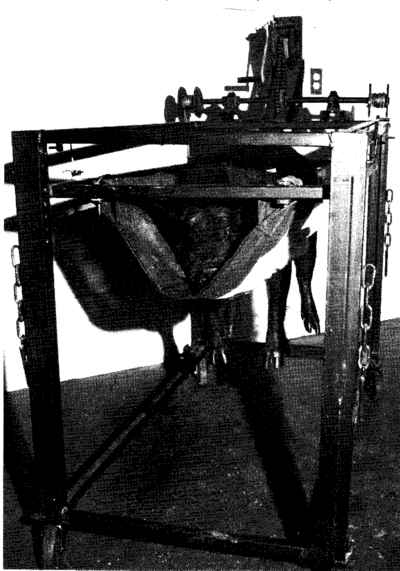
Figure 5. Slings make the best restraints for pigs. The pressure on the belly seems to have a calming effect. Photo by Linda Panepinto.
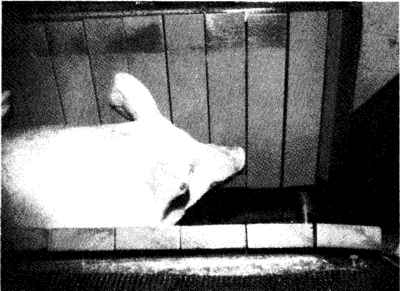
Figure 6. The V-restrainer is used in the meatpacking industry but may have application in biochemical research with pigs.
One of the most useful devices for restraining pigs during research is the swine sling. It is more comfortable and easier to use than most other restraint devices (29-31). Most slings are made from a heavy cotton or canvas material. They have four leg openings (some are padded), and some have an opening for access to the anterior vena cava. Swine slings are available in a number of different sizes to accommodate swine as small as 6.5 lbs. (3 kg.) or as large as 330 lbs. (150 kg.). Small pigs can be lifted into the sling by hand. Larger pigs must enter an open topped cage from which a boat winch is used to raise the sling under the pig. With the pig in a sling only one technician is needed to perform procedures such as blood withdrawal, EKG, EEG, and basil metabolism measurement, cardiac catheterization, oral dosing with a tube, hoof trimming, and uterine flushing. In the sling these procedures can be done on well-tamed pigs without anesthesia or tranquilizers and without causing the animals much stress or discomfort. Panepinto et al. showed that Yucatan miniature pigs restrained in a comfortable sling became more relaxed with frequent experiences in the sling (32). Pigs are much less sensitive to outside stimuli while they are feeding. For some research procedures, such as blood pressure measurement, the pig can be confined in a feeding stall and the procedure carried out while the animal is eating. This technique makes possible accurate measurements on calm, unsedated animals. If the pigs are tame, some procedures can be done even without confinement or restraint. For example, IM injections can be given while the pig is eating if, for one to three days prior to giving the injection, the injection site is scratched and petted while the pig eats. This technique will work only if a very sharp needle is used and the substance being injected does not cause any stinging. The method also works better if the pigs are fed specifically scheduled meals rather than having access to food ad libitum.
A V-restrainer is a device used in large meat packing plants. A smaller version of this device may be useful in the research lab. In it the pig is held between two obliquely angled conveyers that form a V at the bottom (33). The pig's legs protrude through the space at the bottom of the V (32). Both the V-restrainer and the swine sling put pressure along the pig's belly, which apparently relaxes the pig and even allows it to sleep in this position. The V-restrainer is easy to clean.
A V-trough is recommended for blood collection from baby pigs and weanlings. This consists of two boards or sheets of metal joined along one edge to form a V-shaped trough. The pig is laid on its back in the trough. Pigs handled gently in the trough will struggle less as experience with the trough increases. Pigs can be relaxed in the trough by gently stroking them on the belly.
A restraining crate with a stanchion for immobilizing a pig's head is commercially available. In this device stanchion bars hold the pig's head by squeezing the animal along the sides of the neck. Pigs usually attempt to back up, and they often react violently when their heads are held in stanchions. For these reasons these devices are seldom required or recommended for use in the research lab.
Electro-immobilizers have recently become available for use as animal restrainers. These devices cause the skeletal muscles to contract. An investigator, E. Lambooy, of the Research Institute for Animal Production in Holland has stated, "Because of the dubious effects on the animal's welfare, the use of such an apparatus cannot be recommended" (34).
1. Panepinto, L.M., Phillip, RW, and Norden, S.E. "The Yucatan Miniature Pig and Minimum Stress Methodology in the Laboratory." Eighth ICLAS/CALAS Symposium, Vancouver, 1983. Gustav Fischer Verlag, Stuttgart, New York, 1985.
2. Hernsworth, PH., Barnett, J.L., and Hansen, C. "The Influence of Handling by Humans on the Behavior, Growth, and Corticosteroids in the Juvenile Female Pig." Hormones and Behavior 15:396-403, 1981.
3. Gonyou, HW, Hernsworth, PH., and Barnett, J.L. "Productivity and Behavior of Pigs Subjected to Different Handling Treatments During the Growth Period * " Paper presented at the Canadian Society of Animal Science, Charlottetown, Prince Edward Island, Canada (Ab stract), 1985.
4. Mertsching, H.J. and Kelley, KW. "Restraint Reduces Size of Thymus Gland and PHA Skin Swelling in Pigs." J Anim. Sci., Supplement 1. 57.175-176 (Abstract), 1983.
5. Ewbank, R. "The Behavior of Animals in Restraint." In: Abnormal Behavior in Animals. Fox, MW, ed., pp. 159-178. W.B. Saunders Co., Philadelphia, 1968.
6. Hernsworth, PH., Brand, A., and Willems, P "The Behavioral Response of Sows to the Presence of Human Beings and its Relation to Productivity." Livestock Prod. Sci. 8:67-74, 1981.
7. Seabrook, M.F "The Psychological Interaction Between the Stockman and His Animals and its Influence on the Performance of Pigs and Dairy Cows." Vet. Rec. 115(4):84-87, 1984.
8. Prince, J.S * "The Eye and Vision." In: Dukes Physiology of Domestic Animals. Swenson, M.J., ed., pp. 696-712. Cornell University Press, New York, 1977.
9. Mayes, H.F. Design Criteria for Livestock Loading Chutes. Technical Paper No. 78-6014, American Society of Agricultural Engineers, St. Joseph, Michigan, 1978.
10. van Putten, G. and Elshof, WJ. "Observations on the Effect of Transport on the Well-Being and Lean Quality of Slaughter Pigs." Animal Regulation Studies. 1(3):247-271, 1978.
11. Grandin, T "Understanding Hog Psychology Simplifies Handling, " Vet. Med. Small Animal Clinician. 77(2):267-271, 1982.
12. van Putten, G. "Handling of Slaughter Pigs Prior to Loading and During Loading on a Lorry." Commission of European Communities Transport Seminar, Brussels, Belgium, July 7-8, 1981.
13. Mayes, H.F. and Jesse, G.W. Heartrate Data of Feeder Pigs. Technical Paper No. 80-4023, American Society of Agricultural Engineers, St. Joseph, Michigan, 1980.
14. Hernsworth, PH., Gonyou, HW, and Dziuk, PJ. "Human Communication with Pigs." J. Anim. Sci., Supplement 1. 57:137-138 (Abstract), 1983.
15. Houpt, K.A. and Wolski, TR. Domestic Animal Behaviorfor Veterinarians and Animal Scientists, pp. 32-66. Iowa State University Press, Ames, 1982.
16. Vanderlip, S.L., Vanderlip, J.E., and Myles, S. "A Socializing Program for Laboratory-Raised Canines." Lab Animal. 14(l):33-36, 1985.
17. Lot, D.F. and Hart, B.L. "Applied Ethology in a Nomadic Cattle Culture." Appl. Anim. Ethol. 5:309-319, 1979.
18. McGlone, J.J. "Influence of Adrenocorticotrophic Hormone on Swine Agonistic Behavior and Dominance." J. Anim. Sci., Supplement 1. 57:139-140 (Abstract), 1983.
19. McGlone, J.J. Aerosolized Androsterone Reduces Pig Aggressive and Submissive Behavior Swine Research Report, Texas Tech University, Agricultural Sciences Technical Report No. T-5-186, p.25, 1985.
20. Grandin, T and Curtis, S.E. "Material Affected Cloth-Toy Touching and Biting by Pigs." J. Anim. Sci., Supplement 1. 59:50 (Abstract), 1984.
21. Grandin, T, Taylor, I.A., and Curtis, S.E. "Time Patterns of Toy Play." J Anim. Sci., Supplement 1. 63: In press (Abstact), 1986.
22. Dantzer, R. and Mormede, P "Stress in Farm Animals: A Need for Reevaluation." J. Anim. Sci. 57(l):6-18, 1983.
23. Wood-Gush, D.G.M. and Beilharz, R.D. "The Enrichment of a Bare Environment for Animals in Confined Conditions." Appl. Anim. Ethol. 10:209-217, 1983.
24. Grandin, T "Reducing Stress of Handling to Improve Productivity of Livestock." Vet. Med. 79(6):827-831, 1984.
25. Miller, K.N. and Twohill, S. "A Method for Measuring Systolic Blood Pressure in the Conscious Swine (Sus scrofa)." Lab Animal. 126:51-52, 1983.
26. Reid, R.L. and Mills, S.C. "Studies on the Carbohydrate Metabolism of Sheep: XIV The Adrenal Response to Psychological Stress," Australian J Ag. Res. 13:282-295, 1962.
27. Ray, D.E. et al. "Physical Stress and Corticoid Levels in Steers." Proc. Western Section, Am. Soc. Anim. Sci. 23:255-259, 1972.
28. Veum, TL. et al. "Response of Stress-Susceptible and Stress-Resistant Hampshire Pigs to Electrical Stress: 1. Psychological and Biomedical Effects." J. Anim. Sci. 48(3):446-458, 1973.
29. Carter, R.A., Johnson, P, and Read, M. "A Minimal Injury Restraining Device for Swine." Lab. Anim. Sci. 30(4). 716-718, 1980.
30. Baker, L.N. and Andresen, E. "Restraining Rack and Blood Collecting Technique for Large Pigs." Am. J. Vet. Res. 25(108):1559-1560, 1964.
31. Tumbleson, M.E., Dommert, A.R., and Middleton, C.C. "Techniques for Handling Miniature Swine for Laboratory Procedures. " Lab. Anim. Care. 18:584-587, 1968.
32. Panepinto, L.M., et al. "A Comfortable, Minimum Stress Method of Restraint for Yucatan Miniature Swine." Lab. Anim. Sci. 33(l):95-97, 1983.
33. Grandin, T. "Designs and Specifications for Livestock Handling Equipment in Slaughter Plants." Int. J. Study Anim. Prob. 1(3):178-200, 1980.
34. Lambooy, E. "Electroanesthesia or Electroimmobilization of Calves, Sheep, and Pigs by the Feenix Stockstill." Vet. Quart. 7(2):120-126, 1985.
 Click here to return to the Homepage for more information on animal behavior, welfare, and care.
Click here to return to the Homepage for more information on animal behavior, welfare, and care.